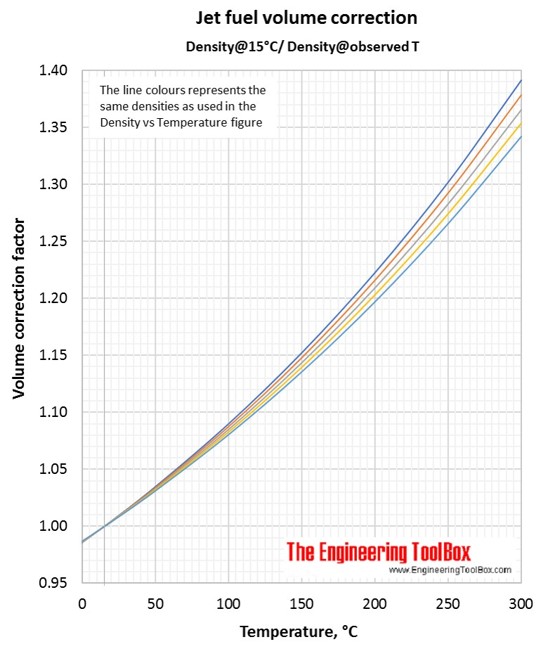

The quantity to be added and approval for its use in various grades of fuel is strictly controlled by the appropriate specifications.Ī few additives in common use are as follows:ġ.
#Jet a1 density vs temperature table code
NATO Code F-34.Īviation fuel additives are compounds added to the fuel in very small quantities, usually measurable only in parts per million, to provide special or improved qualities. JP-8 also meets the requirements of the British Specification DEF STAN 91-87 AVTUR/FSII (formerly DERD 2453). JP-8 is the military equivalent of Jet A-1 with the addition of corrosion inhibitor and anti-icing additives it meets the requirements of the U.S. JP-5 also meets the requirements of the British Specification DEF STAN 91-86 AVCAT/FSII (formerly DERD 2452). Military Specification MIL-DTL-5624U Grade JP-5 (as of Jan 5, 2004, JP-4 and 5 meet the same US Military Specification). JP-5 is a high flash point kerosene meeting the requirements of the U.S. JP-4 also meets the requirements of the British Specification DEF STAN 91-88 AVTAG/FSII (formerly DERD 2454),where FSII stands for Fuel Systems Icing Inhibitor. (As of Jan 5, 2004, JP-4 and 5 meet the same US Military Specification). Military Specification MIL-DTL-5624U Grade JP-4. JP-4 is the military equivalent of Jet B with the addition of corrosion inhibitor and anti-icing additives it meets the requirements of the U.S. In Canada it is supplied against the Canadian Specification CAN/CGSB 3.23 It can be used as an alternative to Jet A-1 but because it is more difficult to handle (higher flammability), there is only significant demand in very cold climates where its better cold weather performance is important. Jet B is a distillate covering the naphtha and kerosene fractions. It is supplied against the ASTM D1655 (Jet A) specification. It has the same flash point as Jet A-1 but a higher freeze point maximum (-40☌). Jet A is a similar kerosene type of fuel, produced to an ASTM specification and normally only available in the U.S.A. Jet A-1 meets the requirements of British specification DEF STAN 91-91 (Jet A-1), (formerly DERD 2494 (AVTUR)), ASTM specification D1655 (Jet A-1) and IATA Guidance Material (Kerosine Type), NATO Code F-35. It is widely available outside the U.S.A. It is produced to a stringent internationally agreed standard, has a flash point above 38☌ (100☏) and a freeze point maximum of -47☌. Jet A-1 is a kerosene grade of fuel suitable for most turbine engined aircraft. There is another grade of jet fuel, Jet B which is a wide cut kerosene (a blend of gasoline and kerosene) but it is rarely used except in very cold climates. Outside former communist areas, there are currently two main grades of turbine fuel in use in civil commercial aviation : Jet A-1 and Jet A, both are kerosene type fuels. Aviation Fuel - Jet Fuel Information Aviation Jet Fuel InformationĪviation turbine fuels are used for powering jet and turbo-prop engined aircraft and are not to be confused with Avgas.


 0 kommentar(er)
0 kommentar(er)
